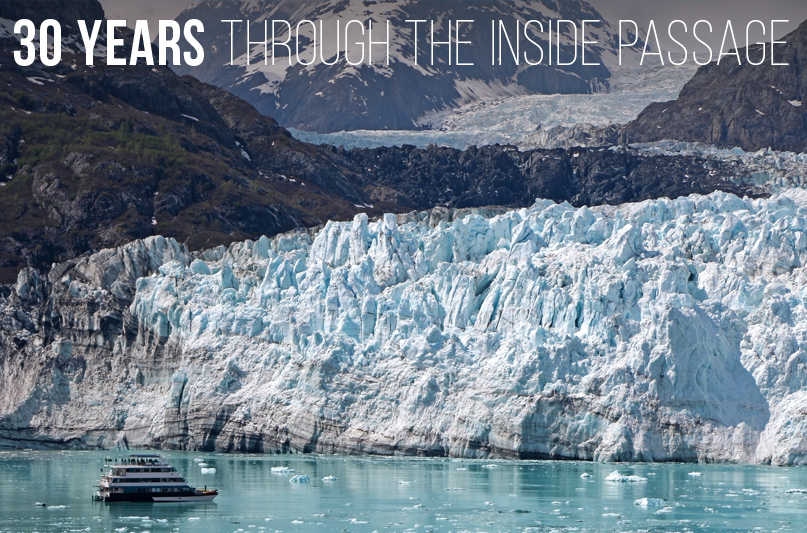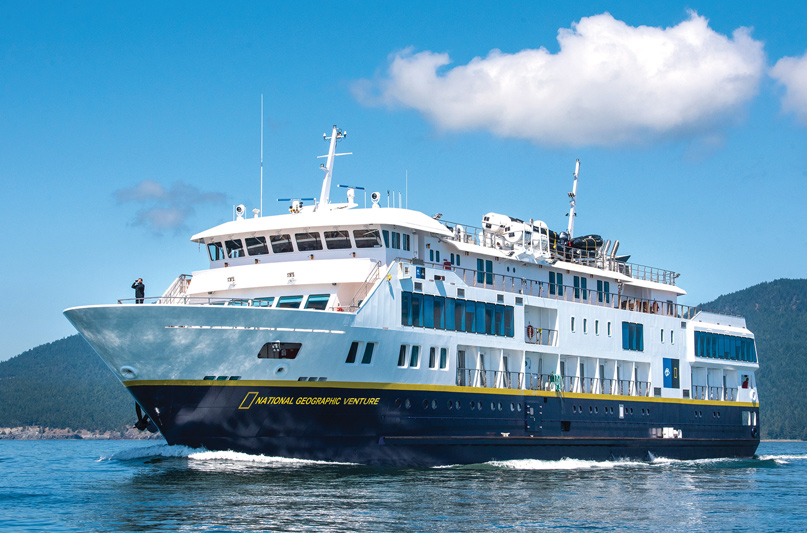
 Here at Northwest Yachting, we truly believe that everyone who travels the Inside Passage to Alaska is an explorer, no matter what kind of boat (or ship) they are traveling on. For many yachtsmen and women, ownership of their own boat is an essential part of the experience, while for others it’s just the journey that matters. At the bottom of the scale (ladder?) are the hardcore people in small open sailboats or rowing skiffs. If that is your craft of choice, I assume you know what you are getting into!
Here at Northwest Yachting, we truly believe that everyone who travels the Inside Passage to Alaska is an explorer, no matter what kind of boat (or ship) they are traveling on. For many yachtsmen and women, ownership of their own boat is an essential part of the experience, while for others it’s just the journey that matters. At the bottom of the scale (ladder?) are the hardcore people in small open sailboats or rowing skiffs. If that is your craft of choice, I assume you know what you are getting into!
If you want to travel in style, but your lifestyle or your budget doesn’t permit ownership of a comfortable cruising yacht, you can charter a fully-equipped yacht, or simply book a vacation with one of the many independent tour operators with dream boats ranging from the traditional wooden vessel to the luxury expedition yacht—sail or power. Each type has its virtues and its drawbacks, but they all offer amazing on-the-water wilderness encounters.
Still haven’t seen what you are looking for? Well, there are still more options at the top of the scale in real ships. On the Alaska Marine Highway ferries, you can stop at ports large and small and find a variety of accommodations. On the cruise lines, you will find all the amenities you can imagine, but time ashore is limited and the huge size precludes getting too close to shore. Somewhere between those two extremes are the small cruise ships that carry up to 100 passengers and are small enough to enter minor harbors and anchorages to get close to wildlife.
If the latter sounds interesting to you, you may want to take a closer look at Lindblad Expeditions, who made the first scheduled “expedition” cruises from Seattle to Alaska in 1980. In the last year, this company has launched two new 238-foot cruise ships equipped with all the latest technology. It’s worth noting they were designed, built, powered and supplied by companies based in the Seattle area that are a part of this region’s successful marine manufacturing sector.
Puget Sound yards have been building ships for the Alaskan trade since the days of the Yukon Gold Rush in 1896 to 1899! The Sound is also where scheduled trips to Alaska generally begin and you can often get a look at them from the shore or the water. In modern times, the Inland Passage route with its magnificent fjords and glaciers has seen a more leisurely rush by the eco-tourism movement to provide cruises in small ships that get close to the sights and animals of the Alaskan coast.
Swedish adventure travel pioneer Lars-Eric Lindblad made history with the first “citizen explorers” cruise to Antarctica. In 1979, Lars-Eric’s son, Sven-Olof, launched Special Expeditions (now Lindblad Expeditions), offering marine-focused small ship expeditions to Alaska soon after.
The Inside Passage route proved sufficiently popular that he added two 150′ (46 m) sister ships to the fleet in 1989-1990 that are still in service 30 years later. They were built by Nichols Brothers Boat Builders of Whidbey Island, Washington, and were renamed Sea Lion and Sea Bird. These twin ships carried 62 guests in 31 cabins and were the perfect size to introduce a new form of tourism to the West Coast, offering up-close encounters in the wild and visits to small ports. With them, Lindblad established an annual itinerary of cruising the Pacific Northwest in the summer and Baja California/Central America in the winter.

This also began Lindblad’s relationship with some of Washington state’s marine businesses that have kept their boats seaworthy and shipshape ever since. The most important of these is Pacific Power Group of Kent, (south of Seattle) that won the contract to re-power the Sea Bird and Sea Lion in 2001. They supplied a pair of 800-horsepower MTU Series 2000s that have been regularly serviced by the company’s factory-trained technicians ever since. With over 17 years of continuous operation, with complete overhauls every 18,000 hours, the ships have achieved an impressive record for reliability and high performance.
Pacific Power also supplied MTU 2000 and 4000 diesels to some of the big catamaran ferries Nichols has been building since the 1980s. They were the first yard on the West Coast to spot the coming trend in fast ferries and tour boats. Coincidentally, it was an encounter with Nichols’ biggest catamaran that was my introduction to the world of commercial boat building in a very serendipitous way.
When I cruised the Inland Passage in 1988, I must admit that I was one of those hardcore sailors who simply had to do it the old-fashioned way—in the smallest and lightest sailboat that had a minimal sleeping cabin. It also had to be fast, stable and easy to build, so that meant a multihull. There was no design available anywhere, so I had to draw the boat and figure out how to build it myself. Twenty weeks later, the result was my 21’ x 16’ home-built demountable trimaran.
That was over 30 years ago, and the details of that first cruise north are a little foggy, but I can still recall sailing along at a modest clip somewhere between Ketchikan and Juneau and suddenly being overtaken by the 104’ four-deck catamaran Executive Explorer that towered above me. It looked like a mirage of a streamlined office block perched on twin hulls, cruising at 13 knots with a fairly small wake.
I was surprised again when I caught up with them that night in one of the small Alaskan harbors that dot the route and was invited on board. One of the crew led me up to the bridge deck, which looked more like a Star Trek set than a working boat. Executive Explorer was launched in 1985 and had all the latest electronics, though they would probably look like antiques today. Then I was led back down the stairs to the salon where I was invited to sample the variety of ice cream desserts laid out in the dining room. Needless to say, that was quite a contrast to the dessert menu on my own boat.
Today, this catamaran, heavily modernized in 2011, is still in service in Alaska, now called the Alaskan Dream. It is still one of very few big catamarans in the world with a full hotel interior that accommodates 40 guests in 18 cabins. Like all its bigger sisters, it can deploy rigid inflatable boats (RIB) and kayaks that are great for exploring around an anchorage with a resident naturalist and guide to lead the excursion. The crew enthusiastically informed me that their boat was built by Nichols Brothers, and seriously suggested I should stop off and visit the yard on my way south since I too was a multihull builder. Looking back, it occurs to me that maybe that this was a very important moment in my writing career.
A few weeks later, I jumped ship onto the state ferry from Juneau to Skagway and hiked the 33-mile Chilkoot Trail over the pass to Lake Bennett, British Columbia, and hitchhiked back. Then I sailed past Glacier Bay and out into the Pacific and along the outer shore to Sitka before I returned to the standard route south. Somewhat the worse for wear after 2,000 miles navigating by map and compass in a very small cockpit, I found myself rowing ashore to the waterfront office of Matt Nichols, one of the two Nichols brothers, while my boat sat at anchor off the Whidbey Island beach.
I was generously given a short tour of the yard by Matt, who was the first builder of big aluminum catamarans on the West Coast. In the three decades since the Executive Explorer was launched, Nichols Brothers has completed about 50 catamarans to become the West Coast’s premier constructor of commercial craft of this type. I’ve also seen two of their luxurious sternwheel river boats docking weekly in my hometown of Astoria during Columbia River cruises, along with off-season visits from the Sea Bird.

So I was pleased to learn in 2016 that they had won the $100 million contract for two new Lindblad cruise ships. Lindblad Expeditions and National Geographic formed an alliance in 2004 that has made them the best-known provider of expedition cruises with a fleet of ten ships offering adventures on five continents. Ten years later, they began planning a new class of expedition ships to be based in Seattle that will be 50 percent larger than the Sea Bird and Sea Lion, but still small enough to maneuver in shallow depths and confined harbors.
They would be the first expedition ships of this size ever designed and built in the U.S. and would be engineered from the keel up to meet the needs of modern expedition travel. When Jensen Maritime of Seattle was chosen to design the new vessel, I began following its progress, but didn’t imagine I would have the opportunity to get a first-hand view of the construction.
I studied the information that Jensen made public and I learned the design was to accommodate 100 guests in 50 spacious outside cabins. The deck plan had to provide maximum visibility of the outside scene in all public spaces and integrate the latest communications and information systems. Other requirements included a forward observation deck, gym, library, and mud room. Jensen’s naval architects used the latest software to model the hull, which was given the dimensions length 238.5′ and beam 44′.

The best hull and bulbous bow shape were selected to reduce fuel consumption at a cruising speed of 12 knots. Then the modern process of “production engineering” was used to integrate all the structural, electrical, mechanical, and HVAC systems into one comprehensive, full-size computer model. The result is a “virtual vessel” that can be inspected early on to verify the layout and access, explained John Edgar, vice president engineering services at Jensen.
When I started writing about commercial boat building in 1989, most shops were cutting out aluminum parts with a circular saw or band saw, then grinding them down to an exact fit. By 2000, the digital revolution had abolished hand cutting; almost every metal boat arrived at the yard as a flat pack of hull parts produced on a cutting table equipped with a moving head that was computer controlled. Today the entire process of design and construction has been computerized as much as possible.
This begins with the naval architects depending on sophisticated design software, then sending the digital information for every single piece to a CNC (computer numerical control) workshop, where industrial waterjets cut and label all the parts. Now it is cut by a water jet with a pressure between 20,000 and 50,000 pounds per square inch blasting through a .010″ to .015”-diameter orifice in a jewel, with a tolerance as close as 0.001″. The builders can pre-fabricate these parts into complete hull modules well before the keel is laid.
In 2017, the National Geographic Quest was launched and joined the Lindblad Expeditions-National Geographic fleet. Work was already well underway on the second ship, the National Geographic Venture, and the hull began to take shape early in 2018. That was when I was given an assignment from a shipping publication to write about the project. When I called Matt Nichols to ask for another tour, the second boat was well under way. The lower hull modules were assembled up to the waterline and the MTU 4000 engines were lowered into the engine room, which was then decked over to create the lower deck.
The complete engine package for each ship consisted of MTU’s latest control and monitoring system, Blue Vision New Generation, as well as a resilient mount system that reduces vibration and noise levels. Shipyards also make extensive use of new technology to direct production and avoid conflicts between the numerous systems and installers. This was the situation when I visited in the spring of 2018.

I followed project supervisor Captain George Capacci through the ship from the engine room up through three decks to the bridge, observing as around 200 craftsmen went about their work in the dimly-lit accommodation areas. All the 50 cabins on three decks are constructed around a “wet” module, George explained. This is a pre-fabricated unit that contains a complete bathroom and shower that must be in place before the interior work can begin. Only then can the plumbing be connected, walls erected, ducts installed, and an amazing number of wires run on hangers above the ceiling panels in the corridor.
This activity is carefully planned to eliminate delays and everyone focuses on one of the hundreds of specific tasks that must be completed on schedule. This was a hands-on way to see the need for all the advance engineering on this high-tech project to ensure the job stayed on schedule. “It’s more like a small, self-sufficient town than a boat,” Capacci reckoned. He joined the shipyard after retiring from the post of operations director at Washington State Ferries, the largest ferry system in the nation.
The ship’s electric system deserves special mention: the raw 480-volt electric power from the Volvo generators is delivered via a bank of regulators and switchboards in the engine room before it is run through miles of wiring into 32 distribution panels all over the ship. They supply everything from the GPS and radar on the bridge down to the Wi-Fi in every cabin.
Once the underlying systems are all in place and functioning properly, the interior fitters and installers take over, turning the basic framework into the environment created by Tillberg Design International. Most noticeable is the incredible visibility from the full-height windows that surround all the beautifully-furnished public spaces—from the lounge adjoining the ship’s bridge and control center to the dining room, lounge, and fitness room with floor-to-ceiling wraparound windows.
For better views on deck, there is a walkway around the entire sun deck and a unique tiered viewing platform on the bow with the anchor winches located on the lower deck. Also, stairways on either side of the bow lead to an expansive observation deck one level up for a higher viewpoint. On the third deck, 22 of the cabins feature small balconies with safety-glass sliding doors. Cabins on the second deck have a large window, and those on the lower deck have two portholes.
All cabins share features like full bathroom with shower, Wi-Fi, temperature controls, and USB outlets for charging camera gear or phones. The internal systems are the best available: the advanced waste management and treatment systems exceed international standards. The new mudroom holds rows of lockers to store guests’ boots, snorkeling equipment and other gear, leaving cabins cleaner and more comfortable. The marine environment can also be enjoyed onboard through state-of-the-art technology like a remotely operated vehicle, video microscope, a hydrophone, and underwater cameras.
The ships are outfitted with a fleet of 24 sea kayaks and eight Zodiac inflatables, stowed on the top deck, to carry all guests on excursions. Also aboard are paddle boards and snorkeling equipment. The stern is configured with overhead hoists and boarding platforms to allow easy use of all watercraft. The ships are equipped with the latest version of the MTU 12V 4000 M54 engines, rated at 1,600 hp for continuous service at 1,800 rpm. These exceptionally clean-burning engines meet the EPA’s Tier 3 emission standards.
I’m reflective as I put pen to paper and look back on the past decades of Inside Passage adventures, the local shipbuilders who help us get there, and the expedition organizations and personalities that bring these cruises together. I still own the same plywood trimaran that started what would turn into a lifelong journey into our Pacific Northwest maritime world. Although I’ll be the first to admit that it’s a little worse for wear, my trimaran and I are living proof that there’s more than one way to enjoy the Inside Passage, and here I am still writing about it! Whether it’s onboard an expedition-style cruise on a Nichols Brothers-made ship or on your own hull, the most important thing is to enjoy the adventure.


